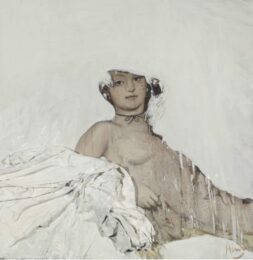

Jordi Diaz Alamà was born in Granollers in 1986, he graduated from the Fine Arts from the University of Barcelona. He also trained at the classical art schools, such as the Florence Academy of Art (Florence) where he learned the techniques used by the great masters of 19th-century painting.
Jordi consolidated his training during a series of stays with contemporary masters of realism such as the Norwegian painter Odd Nerdrum, Guillermo Muñoz Vera as well as Antonio López.
Jordi is the Director of The Barcelona Arts Academy.
His personal work involves an impressive display of pictorial resources with a refined and mannerism-free technique that responds to the canon of contemporary classical figuration, continuously investigating new concepts and plasticities.
His artistic vision has also developed thanks to his teaching role at the Barcelona Academy of Art, which he founded in 2013. It is at the Academy where he grows, expands and shares his knowledge of classical methods, along with the idea that these need to continue to be valued as a tool that help the interpretation and artistic representation of today’s world.
Alamà points out that classical figuration is not the only way but the most direct one to immerse yourself in the world of sensitivity and creative expression.
In 2017, he faced one of the most important challenges of his career with the creation of the work The Cross of the Jubilee, a monumental commission for the Church of the Dolors in Vic (Spain).
In his series #ClásicosDesollados, he merges his implacable technique with bursts of abstraction; cutting, tearing and literally skinning the most iconic works of the great masters from Velázquez to Rembrandt to highlight their inherent modernity.
With the series inspired by Dante’s Divine Comedy, Alamà faces again a monument of universal history, anchored in collective memory, and reaffirms his commitment to contemporary realistic figuration.
His works can be found in the collections of the European Museum of Modern Art and the Can Framis Museum in Barcelona and in private collections in Europe, the United States and Australia.